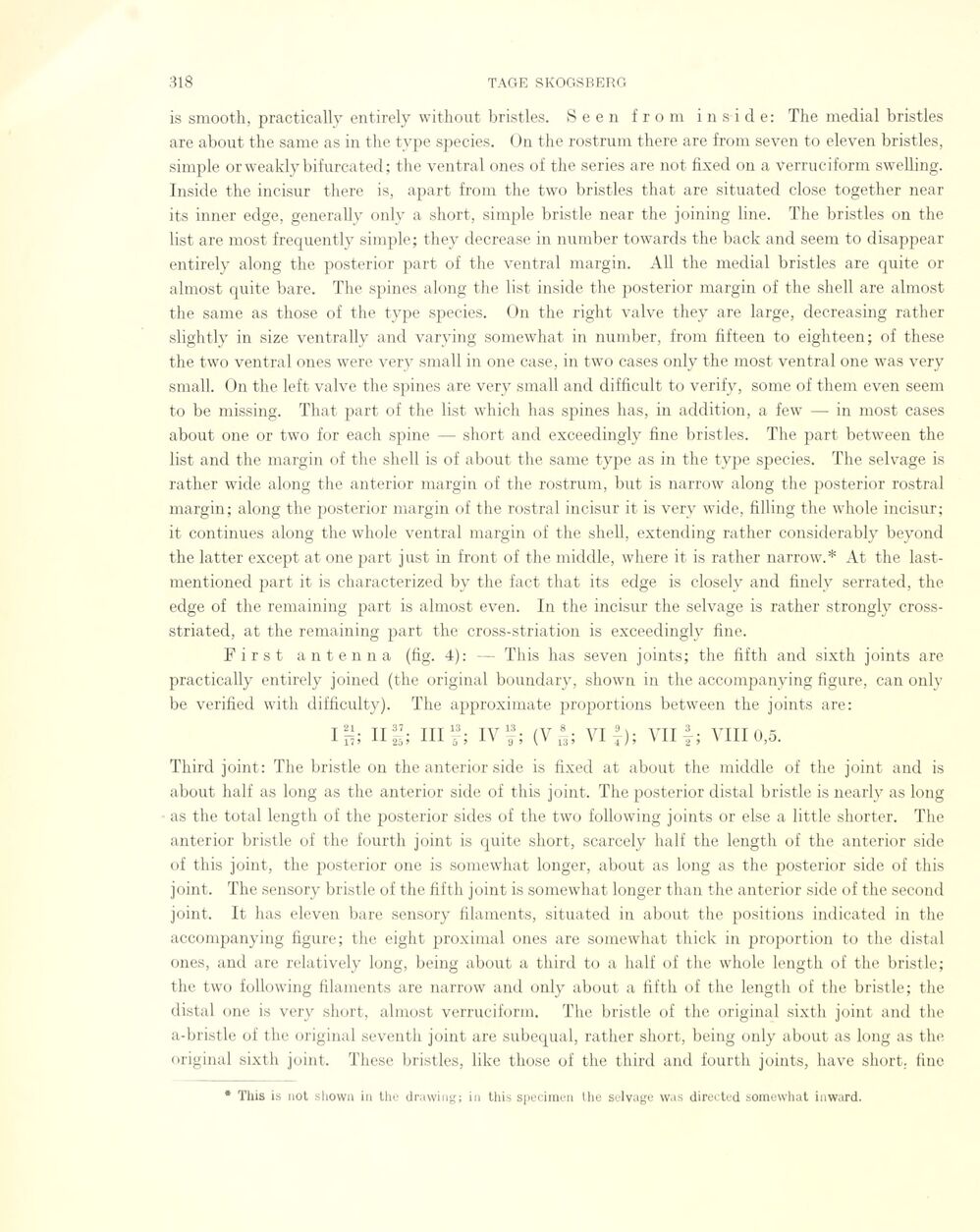
Full resolution (JPEG) - On this page / på denna sida - Sidor ...

<< prev. page << föreg. sida << >> nästa sida >> next page >>
Below is the raw OCR text
from the above scanned image.
Do you see an error? Proofread the page now!
Här nedan syns maskintolkade texten från faksimilbilden ovan.
Ser du något fel? Korrekturläs sidan nu!
This page has never been proofread. / Denna sida har aldrig korrekturlästs.
is smooth, practically entirely without bristles. Seen from inside: The medial bristles
are about the same as in the type species. On the rostrum there are from seven to eleven bristles,
simple orweakly bifurcated; the ventral ones of the series are not fixed on a Verruciform swelling.
Inside the incisur there is, apart from the two bristles that are situated close together near
its inner edge, generally only a short, simple bristle near the joining line. The bristles on the
list are most frequently simple; they decrease in number towards the back and seem to disappear
entirely along the posterior part of the ventral margin. All the medial bristles are quite or
almost quite bare. The spines along the list inside the posterior margin of the sliell are almost
the same as those of the type species. On the right valve they are large, decreasing rather
slightly in size ventrally and varying somewhat in number, from fifteen to eighteen; of these
the two ventral ones were very small in one case, in two cases only the most ventral one was very
small. On the left valve the spines are very small and difficult to verify, some of them even seem
to be missing. That part of the list which has spines has, in addition, a few — in most cases
about one or two for each spine — short and exceedingly fine bristles. The part between the
list and the margin of the shell is of about the same type as in the type species. The selvage is
rather wide along the anterior margin of the rostrum, but is narrow along the posterior rostral
margin; along the posterior margin of the rostral incisur it is very wide, filling the whole incisur;
it continues along the whole ventral margin of the shell, extending rather considerably beyond
the latter except at one part just in front of the middle, where it is rather narrow.* At the
last-mentioned part it is characterized by the faet that its edge is closely and finely serrated, the
edge of the remaining part is almost even. In the incisur the selvage is rather strongly
cross-striated, at the remaining part the cross-striation is exceedingly fine.
First antenna (fig. 4): — This has seven joints; the fifth and sixth joints are
practically entirely joined (the original boundary, shown in the accompanying figure, can only
be verified with difficulty). The approximate proportions between the joints are:
I n; Il I; III f ; IV f; (V®; VI j); VII f; VIII 0,5.
Third joint: The bristle on the anterior side is fixed at about the middle of the joint and is
about half as long as the anterior side of this joint. The posterior distal bristle is nearly as long
as the total length of the posterior sides of the two following joints or else a little shorter. The
anterior bristle of the fourth joint is quite short, scarcely half the length of the anterior side
of this joint, the posterior one is somewhat longer, about as long as the posterior side of this
joint. The sensory bristle of the fifth joint is somewhat longer than the anterior side of the second
joint. It has eleven bare sensory filaments, situated in about the positions indicated in the
accompanying figure; the eight proximal ones are somewhat thick in proportion to the distal
ones, and are relati vely long, being about a third to a half of the whole length of the bristle;
the two following filaments are narrow and only about a fifth of the length of the bristle; the
distal one is very short, almost verruciform. The bristle of the original sixth joint and the
a-bristle of the original seventh joint are subequal, rather short, being only about as long as the
original sixth joint. These bristles, like those of the third and fourth joints, have short, fine
This is not shown in the drawing; in this specimen the selvage was directed somewhat inward.
<< prev. page << föreg. sida << >> nästa sida >> next page >>